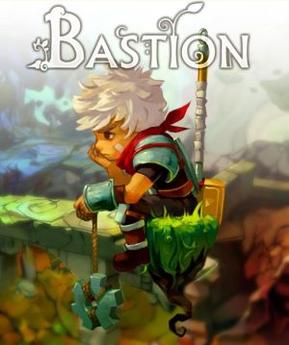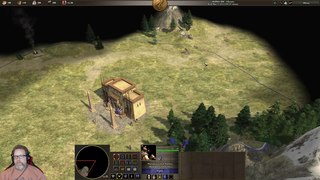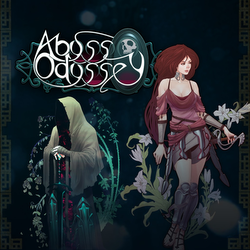
The Maw is an action-adventure video game developed by Twisted Pixel Games and released for Xbox 360 and Microsoft Windows. The game centers on the extraterrestrial Frank and a purple, amorphous creature called The Maw, who have crash-landed their spacecraft on an alien planet. The player assumes the role of Frank and directs The Maw—which can take on the abilities of objects and fauna it consumes—via a leash.
An adventure game is a video game genre in which the player assumes the role of a protagonist in an interactive story, driven by exploration and/or puzzle-solving. The genre's focus on story allows it to draw heavily from other narrative-based media, such as literature and film, encompassing a wide variety of genres. Most adventure games are designed for a single player, since the emphasis on story and character makes multiplayer design difficult. Colossal Cave Adventure is identified by Rick Adams as the first such adventure game, first released in 1976, while other notable adventure game series include Zork, King's Quest, Monkey Island, Syberia, and Myst.

Bastion is an action role-playing video game developed by independent developer Supergiant Games and originally published in 2011 by Warner Bros. Interactive Entertainment. In the game, the player controls "the Kid" as he moves through floating, fantasy-themed environments and fights enemies of various types. It features a dynamic voiceover from a narrator, and is presented as a two-dimensional game with an isometric camera and a hand-painted, colorful art style. Bastion's story follows the Kid as he collects special shards of rock to power a structure, the Bastion, in the wake of an apocalyptic Calamity.

A Let's Play (LP) is a video documenting the playthrough of a video game, often including commentary and/or a camera view of the gamer's face. A Let's Play differs from a video game walkthrough or strategy guide by focusing on an individual's subjective experience with the game, often with humorous, irreverent, or critical commentary from the player, rather than being an objective source of information on how to progress through the game. While Let's Plays and live streaming of game playthroughs are related, Let's Plays tend to be curated experiences that include editing and narration, and can be scripted, while streaming is often an unedited experience performed on the fly.

The Stanley Parable is a story-based video game designed and written by developers Davey Wreden and William Pugh. The game carries themes such as choice in video games, the relationship between a game creator and player, and predestination/fate.

Gone Home is a first-person exploration video game developed and published by The Fullbright Company. Gone Home was first released for Microsoft Windows, OS X, and Linux computers in August 2013, followed by console releases for the PlayStation 4 and Xbox One in January 2016, the Nintendo Switch in September 2018, and iOS in December 2018.

Abyss Odyssey is a platform action-adventure game developed by ACE Team and published by Atlus. It was released in July 2014 for the Xbox 360, PlayStation 3, and Microsoft Windows, and for the PlayStation 4 in July 2015.

Life Is Strange is an episodic adventure game developed by Dontnod Entertainment and published by Square Enix. The first installment of the Life Is Strange series, the game was released in five episodes periodically throughout 2015 for PlayStation 3, PlayStation 4, Windows, Xbox 360, and Xbox One. It was ported to OS X and Linux in 2016, and iOS and Android in 2017–2018.

Hitman Go is a turn-based puzzle video game developed by Square Enix Montréal and published by Square Enix's European subsidiary. Announced in February 2014, the game was released for iOS in April 2014 and for Android in June 2014. Windows and Windows Phone versions were released the following year in April 2015. In February 2016, a "Definitive Edition" version was released on PlayStation 4, PlayStation Vita, and on Linux and Windows via Steam. It is the first game developed by Square Enix Montréal, a studio founded in 2011. Development entered full production in 2013 and was completed by eleven people using the Unity game engine.

Into the Stars is a space simulator video game developed by Fugitive Games, a development team made up of former EA DICE and Spark Unlimited developers, and published by Iceberg Interactive. Following a successful Kickstarter crowdfunding campaign, the game was greenlit and went into the Steam Early Access program.

Downwell is a 2015 vertically scrolling shooter video game with roguelike elements. It was developed by Ojiro Fumoto and published by Devolver Digital for iOS and Microsoft Windows in October 2015, for Android in January 2016, and for PlayStation 4 and PlayStation Vita in May 2016. A Nintendo Switch version was released in January 2019. British studio Red Phantom Games developed the Switch and PlayStation ports.

Dr. Langeskov, The Tiger, and The Terribly Cursed Emerald: A Whirlwind Heist is an adventure video game developed by Crows Crows Crows, a studio created by William Pugh, best known for his work on another video game, The Stanley Parable. The game was released for Microsoft Windows and OS X on December 4, 2015 as a free offering. The game sets up expectations of participating in a narrative-driven story about a heist, but players instead find themselves helping out an unseen narrator before they can participate in the story.

Song of the Deep is an action-adventure video game developed by Insomniac Games and published by GameTrust Games. In the game, the player controls Merryn, a young girl who crafts a makeshift submarine to search for her father who went missing while fishing. The game was released in July 2016 on PlayStation 4, Windows, and Xbox One. The retail chain GameStop published the game, under the brand of GameTrust Games, the chain's first foray into such distribution.

William Pugh is a British game designer best known for his work on The Stanley Parable, and for founding the game development studio Crows Crows Crows.
Fragments of Him is a video game developed and published by Sassybot and released for Microsoft Windows and Xbox One on 3 May 2016 and 1 June 2016, respectively. The PlayStation 4 version was released on 26 September 2017.

Ennuigi is an art, browser and fangame created using PICO-8 that combines Super Mario Bros. and boredom. Ennuigi is a portmanteau of the French word "ennui" and the name of Mario's fraternal twin brother Luigi. The game was designed by Josh Millard.

What Remains of Edith Finch is a first-person exploration video game developed by Giant Sparrow and published by Annapurna Interactive. The game was released in 2017 for PlayStation 4, Windows, and Xbox One; for Nintendo Switch in 2019; for iOS in 2021; and for PlayStation 5 and Xbox Series X/S in 2022.
Davey Wreden is a game designer and developer, best known for his work on The Stanley Parable and The Beginner's Guide.
















